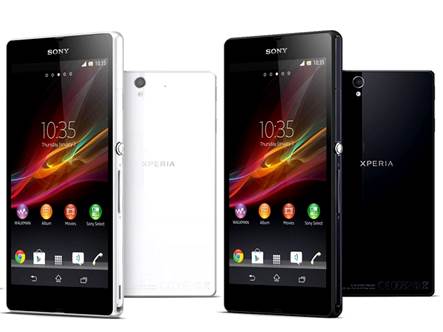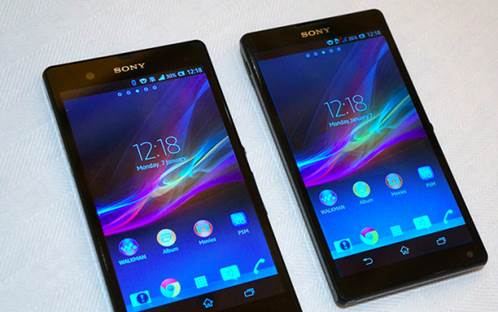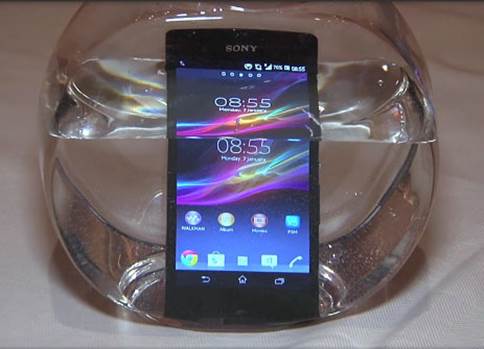Xperia Z is one of the main pillars
for Sony's new strategy to focus on the mobile sector, games and images. In
fact, it is a device aimed at all three of these areas, while also adjusting
the Sony’s smartphone past. The equipment led to a new design language, from
which Sony has also decided to bring to the new tablets. It is called the omni-balance
design, but it is best described as a combination of the angles of 90 degrees;
the weight distribution is flat and glossy edges.

Sony
Xperia Z with the black and white colors
Once you look at the phone by your eyes,
all of the previous Xperias pale in comparison. The phone looks sturdy and you
will hardly think that any part of it is just plastic. Between the glass
surfaces, you will find Sony’s first 1080p phone screen with the size of 5
inches and having benefits from the technology company's new Bravia Mobile
Engine 2. However, the improvements for the Xperia series are not only
aesthetic, but Sony has also added a 13MP camera (with Exmor RS sensor
supporting the HDR video) and a 1.5GHz quad-core Snapdragon S4 Plus, which has
recently been the Qualcomm’s most powerful mobile processor.
Meanwhile, those valuable electronic
components are protected by a waterproof shell (IPX5/7) and dust-resistant
(IP5X). Such protection is rarely seen on a phone that is not advertised as
durable equipment, regardless of talking about a company’s new high-end phones.
Sony is expecting to be successful in the mobile sector, and just a few weeks
from the world's top phone tradeshow, has the company created something that
can resist the current Android champions and won?
Hardware
Where to start with the hardware? It is
here: this is the most beautiful smartphone of Sony ever. The lack of any
removable panel to access the battery means that the components of Xperia Z can
be tucked in a slim appearance with the size of 7.9mm (0.31 inches) and the
weight of 146g (5.15 ounces). It’s partly due to the hidden ports; the light
can bounce from the white sides of the phone. In short, it is a real beauty. It
should be noted that along with black and white choices, you also have the
purple version, which our Spanish team tried.
But while it is a beauty, the expansion of
the 5-inch screen and accompanying bezel mean that this is not the most
comfortable smartphone we have processed. Compared with the sturdy Lumia 920,
the Xperia Z is a little taller, but easier to handle, thanks to the slimmer
shape. In other words, it feels like the DNA Droid rather than Galaxy Note II,
for example. As we have mentioned before, reaching to the phone’s upper edge
proves a little stretch if you use with a hand - we hope that Sony's upcoming
Xperia ZL (with its smaller size) will be easier to handle. Thanks to the
geometric shape, the phone is somewhat uncomfortable to hold after using a long
time, with the sharp edges pressing into your palms. However, we do not have
any problems when putting it in our pockets - something we cannot affirm for
the other phones with 5-inch screens.

Sony
Xperia Z and Xperia ZL
The glass-covered back sets the Xperia Z to
the same group as the Nexus 4 and iPhone 4S, although Sony differentiates its
designs by extending these glass panels to either side. Both the front and the
back include a scratch-resistant layer (not Gorilla Glass), while a glass-fiber
polyamide frame connects all those glass panels together. This frame rounds the
corners between the glass panels; helping smooth these angles to some extent.
Two other noticeable features are the
IPX5/7 and IP5X indexes of Xperia Z. In fact, Sony said that the phone device
can process water at a depth of one meter, and is against sprayed water jets.
It is also designed to make dust stay aloof from the phone's delicate
components. To access the micro-SIM and microSD slots, as well as the headphone
and micro-USB sockets, you'll need to uncover the sealed lids. There is a
rubber lining behind each one to make sure that it is waterproof. We tested it
in the bowls of water and showers, but none of these leading to an emergency
call to Sony to ask for another review unit. The lids also feel sturdy- we do
not worry about their breaking out after using for a long time. You can even
pick up the phone with them (we do not suggest you do that). At the same time,
opening these lids is not harder than opening the battery covers or battery to
access the micro-SIM slot and SD reader.

We
tested the phone devices of Sony Xperia Z in the bowls of water and showers,
but none of these leading to an emergency call to Sony to ask for another
review unit.
While you do not need to open these lids
too often, you will have access to micro-USB port quite often. With all these
mechanical gaps closed, it's good to see some form of wireless charging, given
that it has already been on the rival phones as Lumia 920, Droid DNA and Nexus
4.
Thanks to these port lids, however, the
phone’s streamlined perimeter is discontinued only by the power button, which
will be familiar to anyone who uses the PlayStation Vita. Set off-center along
the length of the right side, it is made of aluminum processed by the machines
(such as volume rocker below it); although you will not have a camera button
this time. Clearly, this is a sacrifice that must be made to ensure waterproof
phones, but it also feels like an obvious omission. The Micro-SIM slot is
located on the same side, while the single loudspeaker is on the bottom of the
right side. Unfortunately, the loudspeaker is small and even at maximum volume
level; it lacks the power during our video playback process.
On the left side, you will see the lids for
the microSD and micro-USB, along with contacts for a dock that is unseen yet.
Turn your phone to the glossy back (but not leaving the fingerprints), you'll
find the main 13-megapixel camera, flash and second mic. Fortunately, the lens
is slightly indented, which will protect it from scratches. When we pulled the
phone out of its box, there was a removable NFC sticker, but on the other hand,
the Xperia logo and a few serial numbers are at the bottom to break the white
surface.
On the front of the phone, there is no
white panel (except for a small piece on the side), with black border fitting
around a 5-inch screen. At the top, you will see the front 2-megapixel camera
with Sony's Exmor R sensor - and it also supports HDR! Below the screen, there
is nothing out of the phone's mic. The Xperia Z has buttons on the screen
instead of for any capacitive keys.